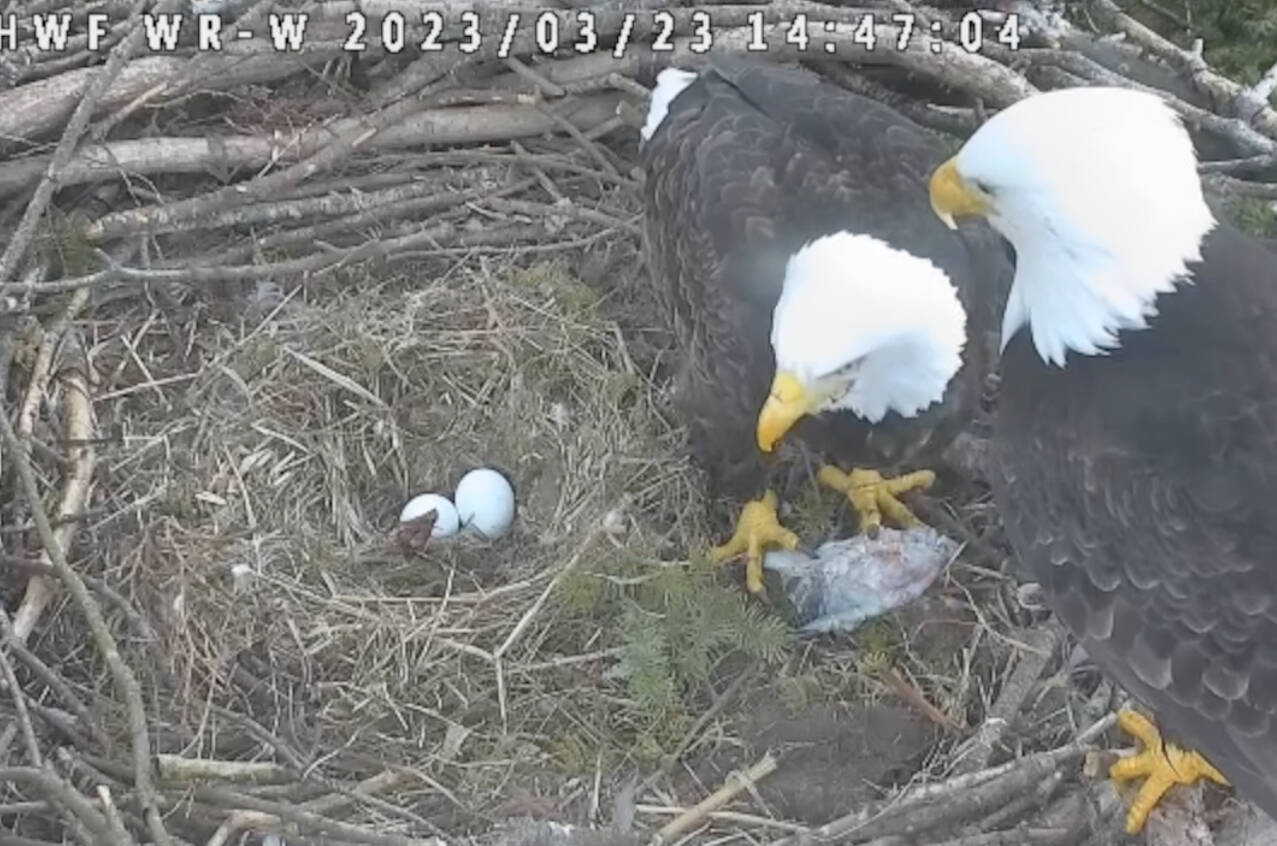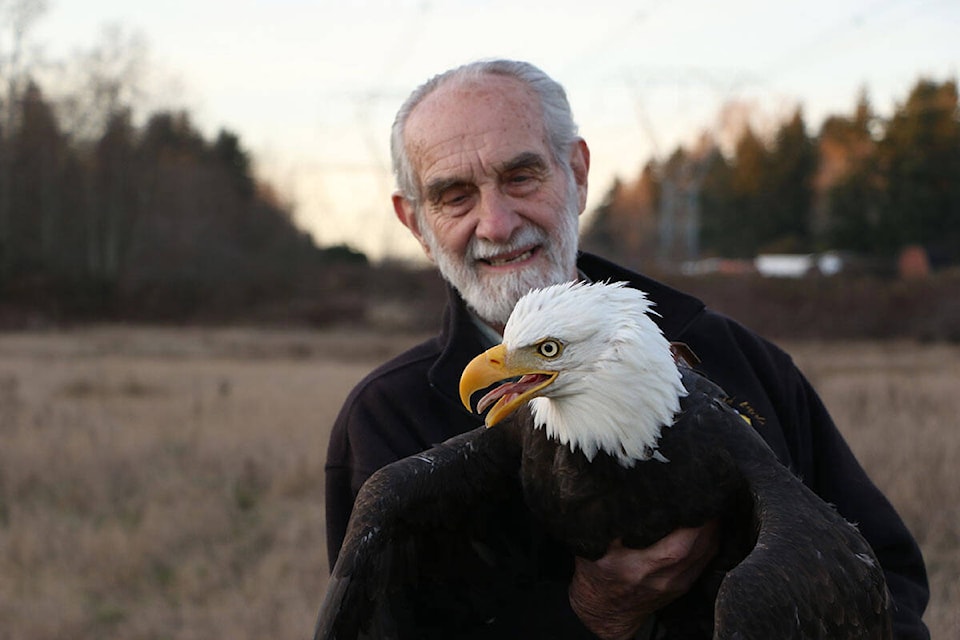There’s been some excitement in the bald eagle-watching community, with the arrival of the first eggs of the season in a White Rock nest.
Located on a private portion of the White Rock bluff overlooking Boundary Bay, only about 100 feet from the back porch of a private home, the nest is captured on three cameras and featured on a 24/7 livestream.
The first egg was laid on March 17; the second followed three days later, on March 20.
“We’re at the busiest time of the year with eagles – they’re all in the middle of laying eggs, or just finished, or just about to start,” said local biologist David Hancock, founder of the Hancock Wildlife Foundation, whose website – hancockwildlife.org – features several live eagle nest cameras.
Then, at 4:22 p.m. on Friday, March 24, according to the Hancock Wildlife Foundation’s Facebook page, the South Surrey bald eagle pair laid their first egg, in their nest near 0 Avenue and 172 Street
“Congratulations to Brit and Rey. At 4:22 p.m., Friday afternoon, their first egg was laid. Brit gave us the first view at 4:43 p.m.,” the Facebook post said.
Updated on March 28, a Facebook post noted Brit had since laid a second egg, at 3:01 p.m. on Monday, March 27.
Eagles usually lay one to three eggs, which take around 37 days to hatch, Hancock said.
While the White Rock nest is the first to feature eggs and the South Surrey nest is the second, there is one other eagle pair
The nests were built by the foundation, a non-profit society aiming to promote the conservation and appreciation of wildlife and their habitats through science, education, and stewardship.
“We build nests because trees just aren’t big enough with the right branch structure to support… they like our job better than their own. We can build them better,” Hancock said, noting that tall trees that are large enough and strong enough to support bald eagle nests are usually the first to be cut down when development happens.
The Delta eagles are both mature adults; the Surrey Reserve nest – located on a half-acre bald eagle preserve made possible by Hancock, developers Dawson & Sawyer, the City of Surrey, and the province – is now home to a new pair of younger eagles (Brit and Rey), only five or six years old.
There had been another pair using the nest, but the male disappeared late last year and the female “got beaten up, we think by the other new female.”
“This will be their first year breeding – we’re hopeful that they’re just a bit later than the White Rock pair… the fact they’re both young birds – we weren’t overly optimistic they’d get it all together this year, but they seem to be trying and that’s the best you can hope for – so whether they’re successful or not is the thing,” Hancock said, prior to their first egg being laid.
READ ALSO: South Surrey nesting eagles welcome first egg of the season
“We coax them on with good spirits but they have to get together with themselves and figure out how to properly create a home – we’ve got the foundation there for them, but they have to do all the intricate work of building the nest up and they have to do their mating correctly, which is a learning function, and then they have to figure out can they co-ordinate catching food for babies and all that kind of thing – it does take practice.”
While he and others are hoping they’ll pull it off, Hancock noted that “usually what happens, is one mature bird is lost and the other mature bird gets a new partner – often a younger one – that comes into the breeding cycle.”
Even with both parents keeping an eagle eye on the nest, it literally takes a raven “about three seconds” to steal an egg.
“It happens. They land on the nest, they grab the egg and they’re gone,” he said, noting that when parents exchange incubating duties is often when ravens will strike.
“At the exchange some birds haven’t learned – initially – if you move off and he moves on, if there’s dilly dallying around one covering up after the other leaves, boy, we’ve seen it on the cameras. The raven is there and BAM! He’s got the egg and it’s gone.”
Watching the eagles can be funny as well, with some behaviours strikingly similar to humans.
“The female absolutely, absolutely controls the nest,” Hancock said.
“You can see a male – he brings in a stick, places it, looks at it, then takes it and places it again – he’ll spend 25 minutes placing the stick. Then the female comes and lands and she walks over, immediately picks up that stick and puts it somewhere else.”
There are 680 occupied eagle nests from Horseshoe Bay/Point Roberts to Hope, Hancock said, noting his foundation just signed a contract to record the City of Chilliwack’s eagle nests, to be a resource that the city, developers and builders can check before building, as every bald eagle nest is protected by law.
That’s a huge change from the 1950s, when there were only three eagle nests in the entire Fraser Valley.
Back then, no predators were protected at all, Hancock remembered. Americans would head up to Alaska for summer fishing and would “take a bucket full of eagles’ legs and pay all their gas there and back… gas was only 23 cents a gallon back then,” as they could get $2 bounty for eagle legs, so they could kill as many as they liked.
About to turn 85 on April 1, Hancock has been passionate about saving wildlife since he was 14, when got his first eagle from the fish and game branch, as there were no wildlife rehabilitation facilities back then.
“I became the first formal (wildlife) rehabber on Vancouver Island… I’ve had hundreds, even thousands, of birds and animals – that’s how I got started,” he explained. “I was the kind of person who would take the things when they were turned in, so I became a rehabber, then a biologist.”
He also made wildlife films for years and started a publishing company for specialized books about conservation.
If someone knows of an eagle’s nest, Hancock actively encourages them to contact him through his foundation or through its many volunteers, so they can add it to their database of the Lower Mainland and Fraser Valley.
“I’ve been doing this for a long time. I’m still as enthusiastic about trying to save things now as I was then,” Hancock said. “It’s more important today than it was then – we destroy things at such a rate, so it’s still important.”
@Canucklehedd
tricia.weel@peacearchnews.com
Like us on Facebook and follow us on Twitter.

